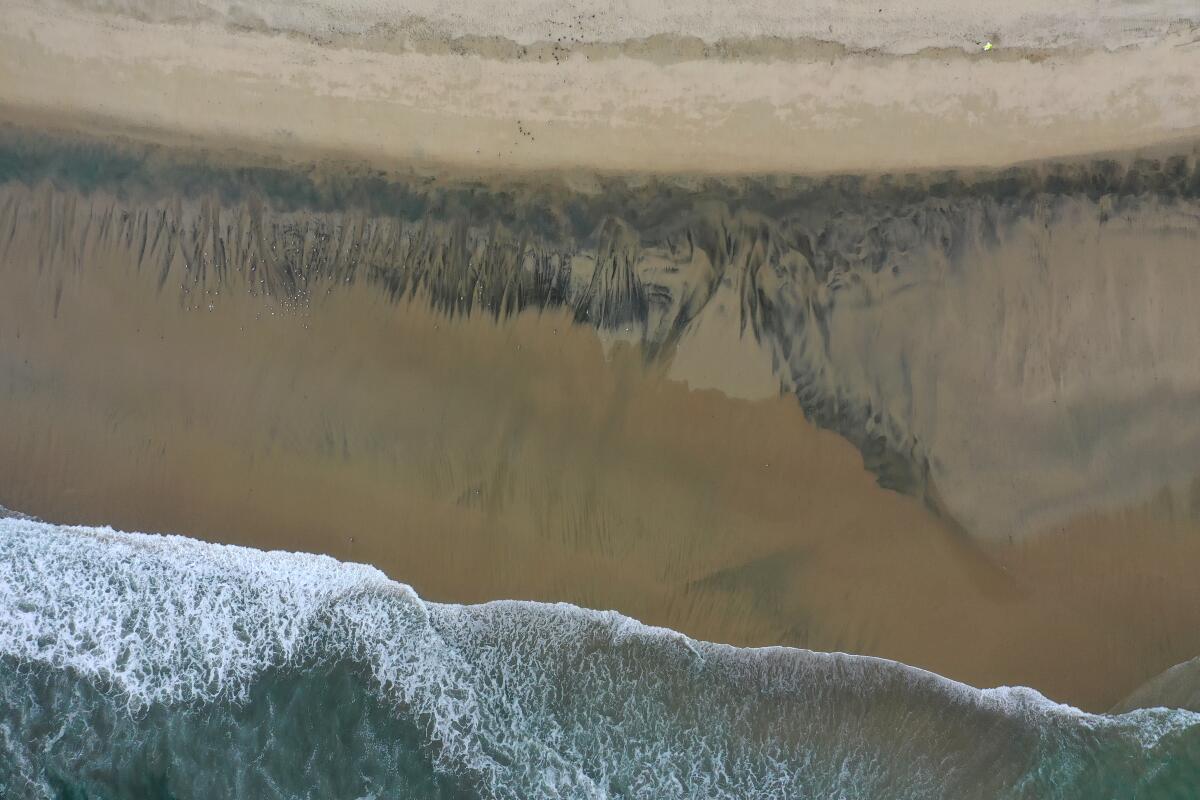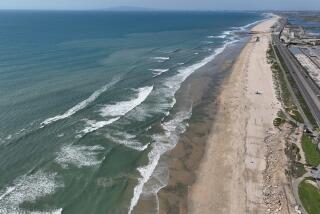Permit problem stalls investigation into Huntington Beach oil spill

- Share via
A federal investigation into the October oil spill that tarred the Orange County coast has been stalled for several months while officials wait for permission to cut apart, remove and analyze a portion of the ruptured pipeline.
The U.S. Coast Guard said Wednesday that the agency is still waiting for permits from federal officials before cutting apart the San Pedro Bay pipeline and transporting the damaged section to a lab for analysis.
That analysis, which was expected to start in 2021, could help reveal how long ago the damage to the pipeline occurred, a key factor in determining responsibility for the disaster.
Coast Guard and National Transportation Safety Board investigators currently must rely on video captured during underwater inspections of the pipeline. Without a more detailed forensic examination of the damage in a laboratory, investigators won’t know if they should continue pursuing their initial line of inquiry or shift the probe in a new direction.
“We need this pipeline to really know what happened,” said Capt. Jason Neubauer, who is overseeing the Coast Guard’s major accident investigation with the assistance of the NTSB. “Until we have it, we aren’t going to make the progress we want.”
The permit to cut apart the pipeline is still being reviewed by the U.S. Army Corps of Engineers.
The Rivers and Harbors Act of 1899 makes it illegal to obstruct navigable waters in the U.S. unless the Corps has authorized the work. The agency’s Los Angeles district is reviewing an application to remove and replace two sections of the San Pedro Bay pipeline, which would require working and erecting structures in navigable waters, said spokeswoman Dena O’Dell.
The Army Corps review of the pipeline work requires coordination with other federal agencies and regulators, including the Coast Guard, the Pipeline and Hazardous Materials Safety Administration and the National Marine Fisheries Service, she said.
Amplify Energy Corp., whose subsidiary operated the pipeline, is working cooperatively with federal agencies, said spokeswoman Amy Conway.
“We look forward to receiving the additional required approvals from the relevant regulators and safely executing the next stage of the repair plan, which will remove and replace the damaged pipeline, so that regulators and investigators can examine it and gain critical learnings for the entire maritime and energy industries,” Conway said in an email.
The federal investigation will also eventually identify the parties at fault for the spill, which sent at least 25,000 gallons of crude gushing into the waters off Orange County.
Crude from the spill seeped into the coastal marshlands and left birds slicked with oil. Local businesses, including fisheries and tourism companies, were shut for days after beaches were closed to the public.
The Coast Guard suspects that a cargo ship dragged its anchor across the pipeline during a storm in January 2021, displacing part of the pipeline and stripping away its concrete casing. That strike could have made the pipeline more vulnerable to other damage or to environmental stressors.
Investigators have identified and boarded two container ships, the MSC Danit and the Cosco Beijing, at the Port of Long Beach, and designated their owners as parties of interest in the investigation. The owners, based in Switzerland and Greece, are also named as defendants in a consolidated lawsuit filed by more than two dozen Orange County businesses and residents seeking compensation for the effects of the spill.
Neubauer said the NTSB lab will use an electron microscope to determine the estimated date of the damage because there are still “some questions as to when the fracture occurred and the nature of the damage.”
The pipeline was intact in October 2020 when it was last inspected, the Coast Guard said last year.
Underwater video and photographs show marine growth on the ruptured pipeline, suggesting that the anchor drag did not happen just before the spill.
Research on the biological growth on the pipeline is almost complete, Neubauer said, and could reveal how long the potential breach in the pipeline existed before oil was seen on the water‘s surface.
Neubauer said the litigation is likely to factor into the investigative timeline. The federal court could issue orders or a motion could be filed that restricts federal authorities’ ability to touch the pipeline. He said an extensive examination of the pipeline has been done by various parties underwater, but it ultimately wasn’t scientifically precise enough to make findings about the spill.
The federal report’s findings could have a dramatic impact on the civil litigation, which is seeking class-action status, as well as on the criminal charges filed against Amplify Energy Corp. and two of its subsidiaries.
A grand jury indicted Amplify, Beta Operating Co. and San Pedro Bay Pipeline Co. in December, charging that the companies illegally discharged oil into federal waters from the pipeline they operated off Huntington Beach.
The criminal indictment alleged that the 17.3-mile underwater pipeline, running from a production and processing platform called Elly to the Port of Long Beach, was being operated by “an understaffed and fatigued crew” that “had not been provided sufficient training regarding the pipeline’s automated leak detection system.”
No individuals are named in the indictment. The charge of negligently discharging oil, a misdemeanor, carries a statutory maximum penalty of five years of probation for a corporate defendant, as well as fines that potentially could total millions of dollars.
Prosecutors alleged that the pipeline operators repeatedly failed to “properly respond” to a leak detection system that went off eight times over 12 hours. The first alarm occurred at 4:10 p.m. on Oct. 1, as some Orange County residents began to smell petroleum near the coast.
The alarms repeated nearly every hour until 11:30 p.m. During this time, according to the charges, operators responded to five of the alarms by “shutting down and restarting” the flow of oil through the pipeline. Oil continued to be pumped through the pipeline for three additional hours until “approximately 2:27 a.m.,” the indictment said.
After the eighth and final alarm at 5:28 a.m. the next day, crews allowed oil to pass through the pipeline for nearly an hour after a boat they had contacted failed “to locate an oil discharge from the pipeline in darkness in the middle of the night,” the indictment said.
The company has said previously that offshore platform workers and onshore pipeline workers for Amplify Energy believed the leak detection system was sending false alarms and tried to troubleshoot it.
More to Read
Sign up for Essential California
The most important California stories and recommendations in your inbox every morning.
You may occasionally receive promotional content from the Los Angeles Times.












